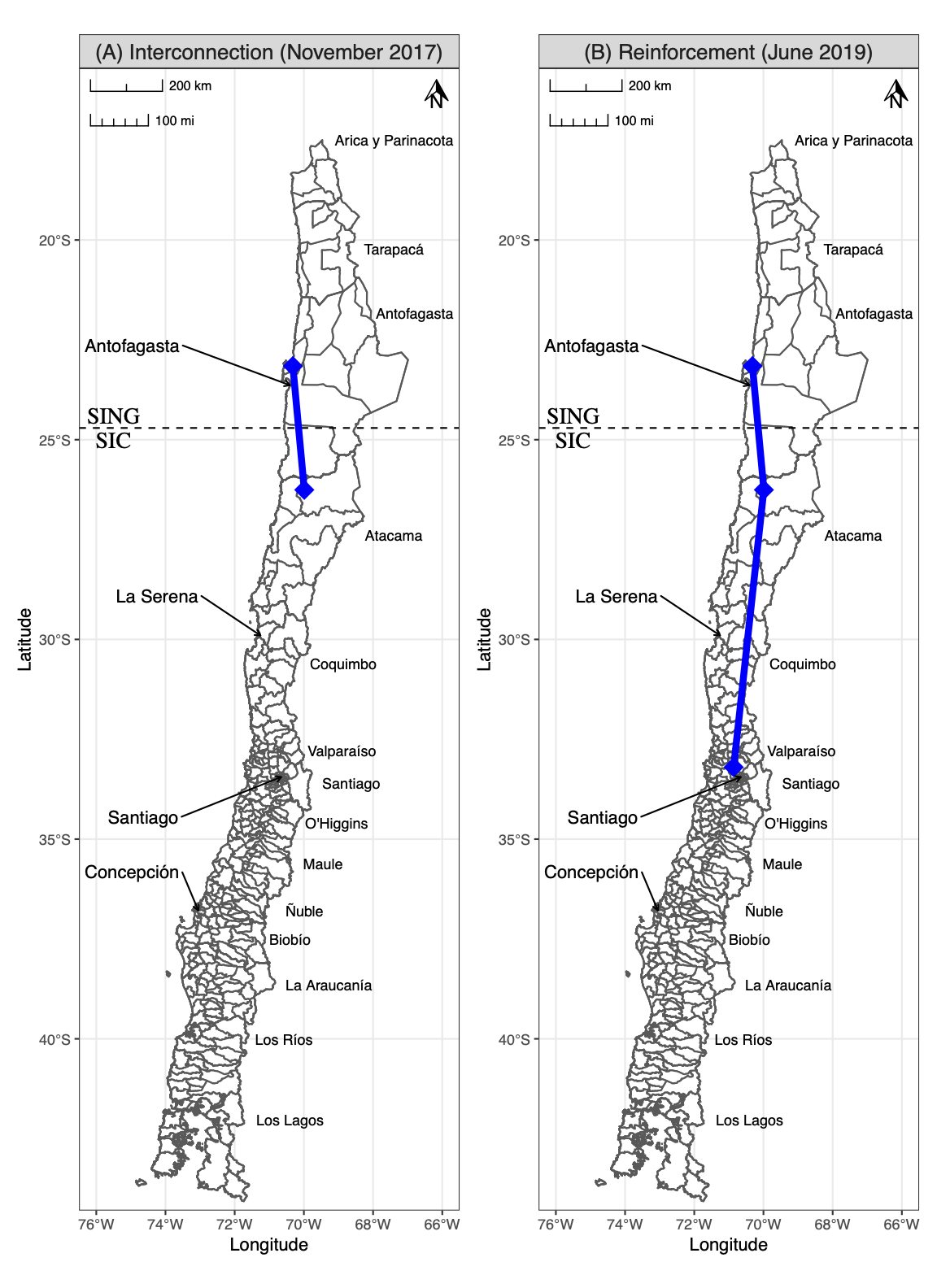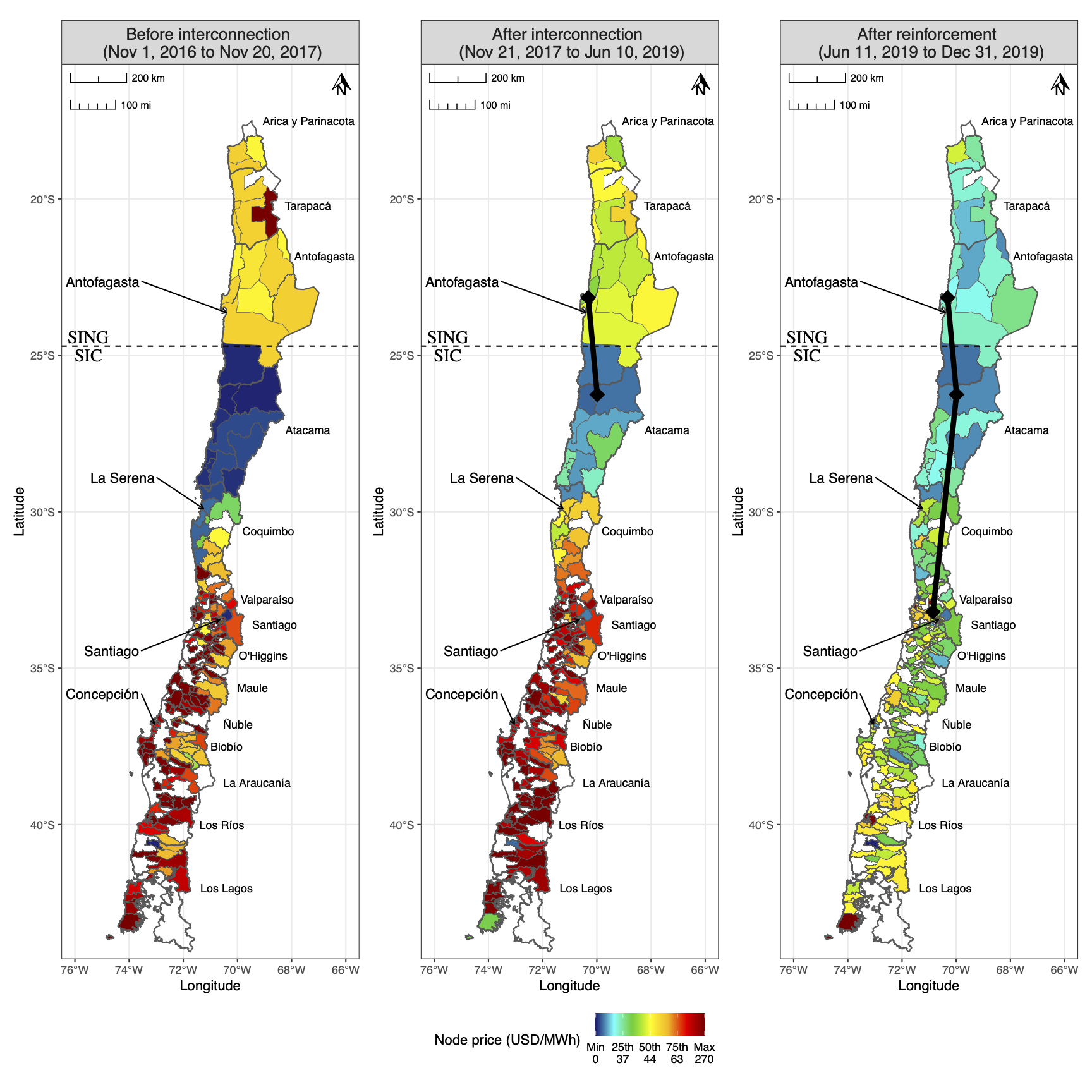
Expanding electricity transmission lines reduces regional price disparities in electricity, boosts renewable energy, and lowers the overall cost of electricity
The battle for decarbonisation is being lost. We are way off track in limiting global warming to 1.5°C, or even to 2°C. According to the IMF (2022), US$1 trillion is needed in energy infrastructure investment before 2030 to enable greenhouse gas mitigation in emerging economies.
Recently, Chile managed to more than double the proportion of electricity it generates from renewable energy, going from solar and wind power generating 10% of the total electricity in 2017, to almost 28% of the total electricity in 2022 (Generadoras de Chile 2022). When all the renewable energy generation sources are considered, including hydroelectric, geothermal and biomass, the percentage of renewable generation at the end of 2022 surpassed 55% of the total, higher than the 45% of thermal generation.
However, a worrying development is the significant curtailment of generated renewable energy. This is caused by the difficulties in transporting generated energy due to the lack of transmission lines that connect large consumption centres. For instance, up to 290 Gigawatt hours of wind and solar power-generated energy was not used in 2022 (ACERA 2022).
One of the obstacles that countries face in accelerating their transition to a low-carbon economy is shortening the distance between consumption centres (e.g. large cities) and renewable energy sources (solar, wind, and others). These barriers being eliminated by better transmission infrastructure can cause an expansion in the production and use of renewable energy.
Our study
We examine this question by providing a theoretical and empirical analysis of the impact of market integration on renewables expansion and allocative efficiency in wholesale electricity markets (Gonzales et al. 2022). We begin by developing a simple theoretical model that characterises the static and dynamic impacts of market integration. We assume market integration does not affect producers' entry decisions in the static scenario. In this case, the value of market integration can be summarised by a conventional definition of gains from trade. Market integration allows lower-cost power plants to export and replaces production from higher-cost power plants, which reduces the overall cost of electricity production.
Likewise, considering the dynamic impact of market integration makes it possible to capture the anticipation in investor expectations and changes in supply due to the greater investment in installed capacity. By having information on market expansion, investors can make the decision to bet on the capture of expected future profitability. In the same way, greater investment changes production (supply), thus modifying the short-term or static equilibrium.
Our theory suggests that the static gains that can be estimated by a conventional analysis could substantially underestimate the full gains from market integration. To get at the full dynamic gains from trade, one would need to compare these benefits to the costs of building the line and the costs of the solar investment.
The Chilean electricity market
With this insight, we empirically quantify these theoretical predictions by exploiting two large changes that recently occurred in the Chilean electricity market. Until 2017, two major electricity markets in Chile - Sistema Interconectado Norte Grande (SING) and Sistema Interconectado Central (SIC) - were completely separated, with no interconnection between them. This separation was subsequently recognised as an obstacle to the expansion of renewable energy, as renewable-intensive regions (near the Atacama Desert) are located quite far to the north of demand-centred regions (near Santiago, the capital city). To address this problem, the Chilean government completed a new interconnection between these two markets in November 2017, and an additional extension transmission line in June 2019 (see Figure 1).
Figure 1: Market integration in the Chilean electricity markets

What are the effects of market integration?
Aware of accounting for short-term and long-term effects, we first look at the immediate effects of the integration of these two markets on wholesale electricity prices, production, costs, and install capacity of renewable energy.
First, we show that prices converge across regions after the complete integration of markets. Before the integration, the price difference between SING and SIC was significant, with some isolated regions where there were curtailment problems, such as the Atacama Desert area. We show that market integration substantially reduced this spatial price dispersion by increasing prices in renewable-intensive regions and decreasing prices in demand centres (see Figure 2).
Figure 2: The impact of market integration on spatial variation in electricity prices

Second, we find that the market integration allowed lower-cost power plants, including renewable energy plants, to increase their production, which replaced production from higher-cost plants. We find that the market integration resulted in a decrease in the cost of electricity generation per Megawatt hour. This empirical result is in line with the theoretical prediction from gains from trade.
Third, we find that the expectations of investment in renewable energy are triggered around the time of announcement of the construction of the electric transmission line in 2015. In addition, we find that the wholesale electricity prices in renewable-intensive regions were near-zero between 2015 and 2017 (i.e. after the announcement of the new transmission line but before the openness of the line) and increased to a profitable level for renewables only after the market integration in 2017. This evidence suggests that renewables investors made their investment decisions based on the anticipation of market integration.
To investigate the potential dynamic impacts of market integration, we build a structural model of power plant entries with renewable investments. In the model, investors consider investment for a new power plant based on the expected value of long-run profit from the investment. The net present value of the investment depends on the profit from subsequent years. A key element to the future expected profit is transmission constraints from its local region to other regions. The attractiveness of the Chilean market is that its simple geography makes the network model tractable, and makes it feasible to conduct counterfactual analysis. We simulate a few counterfactual policies on transmission capacity expansion to examine each policy’s impact on capacity investment in renewables, node prices, profits, and consumer surplus.
The significance of these results
Our counterfactual simulations reveal several findings. First, our static result suggests that the market integration resulted in a 17% increase in solar power generation relative to the counterfactual case with no market integration. This is because in the absence of market integration, the system operator would have had to curtail excessive amounts of solar power due to transmission constraints. Second, this number still understates the impact on solar investment because a substantial amount of solar investment would have become unprofitable without market integration due to low market prices. In contrast to these static results, our dynamic result suggests that the full impact of market integration on solar power generation was a 45% increase in generation, as opposed to the 17% increase if we ignore this dynamic impact.
Our results indicate that both the static and dynamic impacts of market integration are important factors in the evaluation of transmission investment. In our context, we find that the static effect itself resulted in 10.1% and 4.9% reductions in electricity generation cost per megawatt hour in hour 12 (a solar-intensive hour) and all hours, respectively. If we incorporate the dynamic effect on solar investment, these reductions in generation cost are higher, at 13.6% and 6.3%. Our simulation results also indicate that both the static and dynamic impacts play key roles in the price convergence across regions.
Many countries are looking towards expanding their renewable energy sector, and will need to invest in increased transmission lines to achieve that. The Biden administration in the US, for example, considers investment in transmission lines and renewable energy to be a key part of the Infrastructure Investment and Jobs Act that became law in November 2021. Our theoretical model and empirical evidence therefore provide several key implications related to the design of the new transmission infrastructures across the world.
References
ACERA 2022, “Generación renovable se dispara, pero sigue preocupando el nivel de vertimiento”.
International Monetary Fund (2022), “Chapter 2: Scaling Up Private Climate Finance in Emerging Market and Developing Economies: Challenges and Opportunities”, Global Financial Stability Report, Washington.
Gonzales, Luis E., Koichiro Ito, and Mar Reguant (2022). The Dynamic Impact of Market Integration: Evidence from Renewable Energy Expansion in Chile. NBER Working Paper 30016.
Generadoras de Chile 2022, “Sector de generación eléctrica reduce en un 25% sus emisiones de CO2 y alcanza niveles récord de generación renovable en 2022”.



